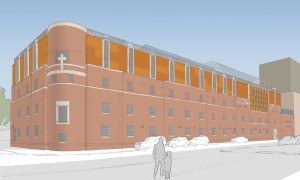Applicants simplified the massing of proposed tower building and reduced its height 32 feet from previous proposal. On May 6, 2014, the Landmarks Preservation Commission approved proposed work at the campus of St. Luke in the Fields Episcopal Church, located on the western edge of the Greenwich Village Historic District. The approved work includes a new residential tower at a site currently occupied by a parking lot at the corner of Greenwich and Barrow Streets. The work also includes additions to an existing school, which would allow it to expand without relocating.
The project was the subject of two previous meetings. At a February hearing, numerous area residents, as well as elected officials, spoke in opposition to the size and scale of the residential tower. At a subsequent March hearing, commissioners opined that the proposed tower was excessively complex, and possessed a surfeit of glass. Some commissioners also found the proposed tower too tall, while others determined that the brightly colored panels on the school addition detracted from the original architecture.
Architect Andrew Bartle presented the revised plans for the school additions. The brightly colored aluminum panels would be replaced with fiberglass cement panels in more muted red orange hues. The upper, panel-clad, tier of the addition would be set back one foot from the lower levels, which would be faced in brick that closely matched the original fabric. The material would also be more energy-efficient. The windows on the interior courtyard side would closely match the existing windows, except on the uppermost fourth floor. The windows on the fourth floor are intended to recall the artists’ studios of Greenwich Village.
Commissioner Diana Chapin found that the revised additions were distinct from the original fabric without calling undue attention to the changes. Commissioner Margery Perlmutter found that the new materials in the revised proposal would add to the “wealth of materials” of the complex. Commissioner Michael Goldblum dissented, finding the revisions “thoughtful,” but he found that the intertwining of the new and old material still appeared “arbitrary” and required further study.
Architect Barry Rice presented the revised design for the residential tower, which would be 121 feet in height compared to the 153 feet proposed in the previous proposal. The massing would be “more robust,” with only one zoning-mandated setback at 60 feet. The fenestration of the building would also be simplified. The building would be clad in Flemish bond brick at the base, with a glass curtain wall on the upper stories. A bris soleil and railing would be installed on the roof.
Commissioner Michael Devonshire praised the “restrained” design of the revised tower, and called it a “well-thought-out building.” Commissioner Goldblum found the simplification and height reduction of the revised tower resulted in a better fit with the district and its immediate surroundings, making it more “subsidiary” to the church tower. Commissioner Perlmutter said the revised plans were “enormously improved” and appropriate in scale and form, but suggested the base be topped with a stronger cornice. Chair Robert B. Tierney said the “process has worked” to facilitate the design of an appropriate building for the district. The commissioners unanimously voted to award the plan a certificate of appropriateness.
LPC: 100 Barrow Street; 657 Greenwich Street, Manhattan (15-1091; 15-1090) (May 6, 2014) (Architects: Andrew Bartle Architect, Barry Rice Architects).
By: Jesse Denno (Jesse is a full-time staff writer at the Center for NYC Law).


